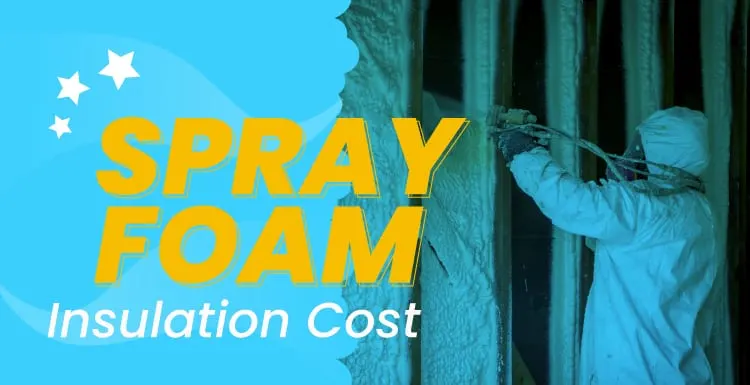Wondering how much spray foam insulation costs? Spray foam insulation has been growing in popularity in the United States because of its superior effectiveness over fiberglass insulation.
Still, for many homeowners, the spray foam insulation cost is a deterrent. Spray foam insulation cost is higher than fiberglass insulation.
But several factors determine the total amount you’ll pay to have it installed. In this guide, we outline the cost of different types of spray foam insulation and professional installation.
Before we dive into the spray foam insulation cost, let’s discuss what spray foam insulation is and why you might consider it over the much cheaper fiberglass insulation.
What Is Spray Foam Insulation?
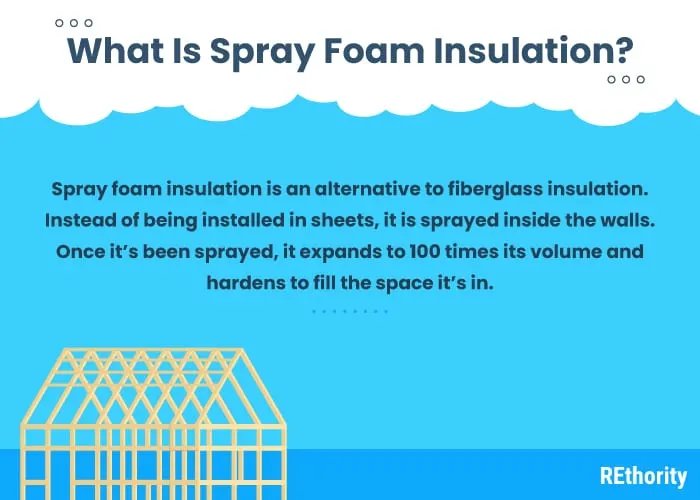
Spray foam insulation is an alternative to fiberglass insulation. Instead of being installed in sheets, it is sprayed inside the walls. Once it’s been sprayed, it expands to 100 times its volume and hardens to fill the space it’s in.
This expansion is part of what makes spray foam insulation effective as insulation, but it also strengthens the structure it’s insulating. There are two basic types of spray foam insulation:
- Closed-cell spray foam insulation
- Open-cell spray foam insulation
The differences between these two types are small but noticeable. Open-cell spray foam insulation is very effective, but the cells that make up its form are broken (open).
In the open cells, lots of little pockets hold and trap air to insulate. Open-cell spray foam is not as rigid as closed-cell once it has cured. Open-cell insulation is also less expensive than closed-cell.
Closed-cell spray foam insulation is much harder than open cell. The cells that make up this type of foam are closed and filled with gas, which enables them to hold their shape better and do an efficient job at insulating.
Closed-cell insulation is more expensive than open cell, but it’s also more durable and an effective barrier to air, moisture, and vapor. Whether it is open-cell or closed-cell, spray foam insulation is made up of 2 parts.
The first is a polymer, like polyurethane. The second is a foaming material. These two materials are mixed during spraying to create the expanding, foaming action.
Below, we talk about how a professional installs spray foam insulation – it’s a complex process that must be done carefully.
Why Consider Buying Spray Foam Insulation?
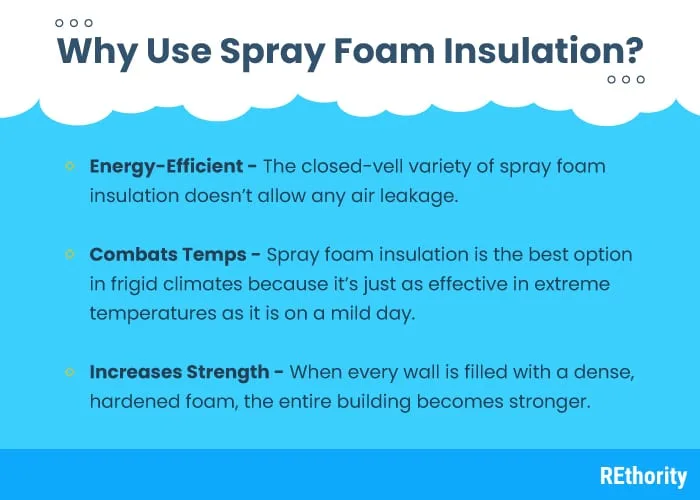
If spray foam insulation is more expensive and has to be installed by a professional, why would a homeowner consider buying it?
There are lots of benefits and advantages to using spray foam insulation instead of fiberglass.
Energy Efficiency
Spray foam insulation is more energy-efficient than fiberglass, which allows about 30% of a home’s heat or air conditioning to escape. The closed-cell variety of spray foam insulation doesn’t allow any air leakage.
And the open cell type only allows minimal air leakage. Fiberglass insulation just can’t fill the small pockets and corners the way spray foam can, and even at peak effectiveness, fiberglass insulation isn’t as energy-efficient.
Spray foam insulation is energy efficient. So much so that many homeowners can offset the cost they paid for it within 5 to 7 years in energy bill savings.
Combats Extreme Temperatures
Spray foam insulation is the best option in frigid climates because it is just as effective in extreme temperatures as it is on a mild day. Fiberglass insulation, on the other hand, loses heat much faster in extremely cold temperatures.
Spray foam insulation’s R-value (resistance to heat flow) is better than any other type of insulation. A higher R-value means the insulation does a better job of trapping heat and keeping it from escaping the house.
It is measured in inches because more inches of insulation material will do a better job at trapping heat. Open-cell spray foam insulation has an R-value of about 3.5 per inch, but closed-cell has an R-value of 6-7 per inch.
It does not lose its R-value over time, unlike fiberglass insulation. Compare these R-values to fiberglass, which is 2.2 per inch.
An R-value of 38 is widely accepted as the insulation goal for a house, so to accomplish it, you’d need a little more than 6 inches of spray foam insulation.
Increases Structural Strength
Spray foam insulation makes a structure up to 250% stronger. When every wall is filled with a dense, hardened foam, the entire building becomes stronger. Also, it lasts for 80+ years, so the added structural strength is a long-term benefit.
Other Benefits
- Spray foam insulation holds its shape and continues insulating where it was applied for 80+ years, unlike fiberglass insulation. It will never fall, shift, or sag.
- Anyone with allergies can get some relief by having spray foam insulation installed. It keeps pollen and dust particles from entering the home.
- Better energy efficiency translates into less wear and tear on household HVAC equipment, making it last longer and decreasing the amount of maintenance needed.
- Has the highest R-value of any other type of insulation (up to 7 per inch)
Average Spray Foam Insulation Cost
Spray foam insulation has many advantages and benefits, but one of the cons to using it is the cost. Spray foam insulation is more expensive than fiberglass insulation.
But one of the two types of spray foam insulation is cheaper than the other. Let’s look at the average cost of spray foam by board foot and overall installation cost.
Spray Foam Insulation Cost Per Board Foot
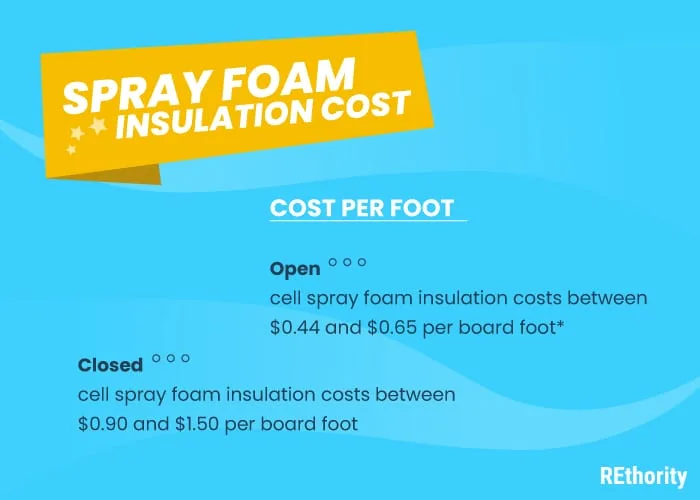
To begin to figure out how much you’ll pay for spray foam insulation, it’s best to start by calculating the rough number of square feet you will need to cover.
When you have the square footage, you can then determine the number of board feet (1 square foot at 1-inch thickness).
- Open-cell spray foam insulation costs between $0.44 and $0.65 per board foot*
- Closed-cell spray foam insulation costs between $0.90 and $1.50 per board foot*
*One board foot is a 1 foot by 1-foot square at 1-inch thickness
Spray Foam Insulation Cost By Thickness
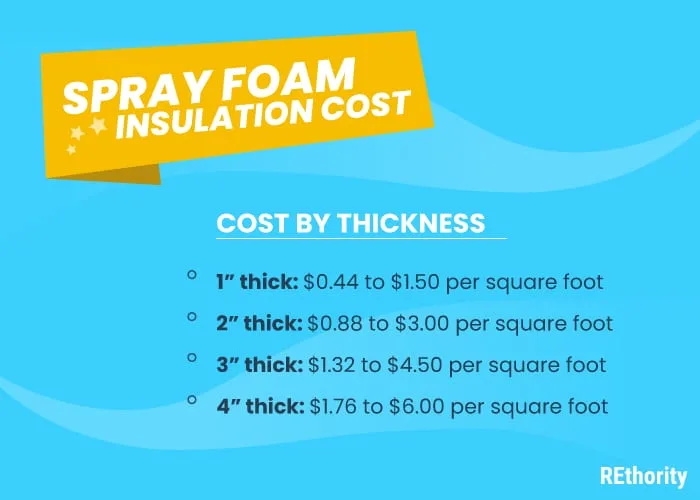
Spray foam insulation should be thicker than one inch to insulate a home properly. The cost of spray foam insulation increases as a thicker layer is applied.
Here’s how the cost of spray foam insulation varies by thickness.
- 1” thick: $0.44 to $1.50 per square foot
- 2” thick: $0.88 to $3.00 per square foot
- 3” thick: $1.32 to $4.50 per square foot
- 4” thick: $1.76 to $6.00 per square foot
Total Spray Foam Insulation Cost
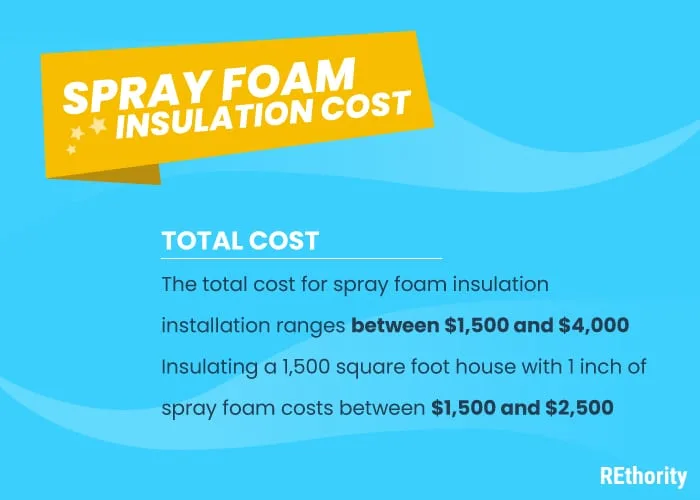
Spray foam insulation has to be applied by a professional because it’s a complicated process that requires precision and skill. You’ll need to hire an expert to install the insulation.
So it’s helpful to know the total cost with materials and installation included, not just the cost of the spray foam insulation.
- Most people pay around $2,500 to have spray foam insulation professionally installed
- The total cost for spray foam insulation installation ranges between $1,500 and $4,000
- Insulating a 1,500 square foot house with 1 inch of spray foam costs between $1,500 and $2,500
In all, spray foam insulation is about 2 to 3 times more expensive than fiberglass insulation.
Factors That Affect Spray Foam Insulation Cost
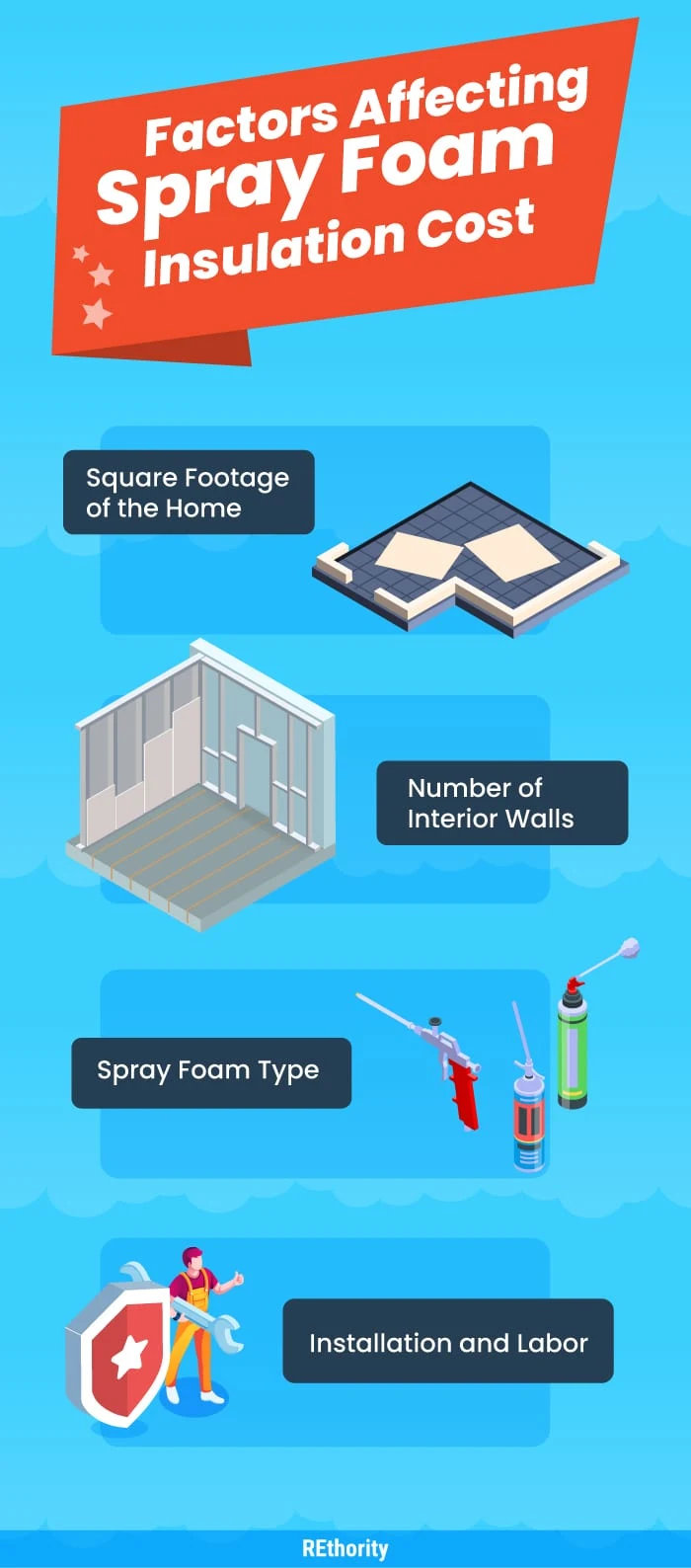
It’s a challenge to come up with a cost estimate for spray foam insulation because there are so many factors that affect the final cost.
Here are factors that can reduce or increase the price you pay for spray foam insulation.
- Square Footage of the Home: Larger homes require more insulation, so if your home is 5,000 square feet, your cost will be much higher than someone who is having a 1,500 square foot space insulated.
- Number of Interior Walls: In addition to the total square footage, the number of interior walls can also affect the final price. If you’ve got lots of small rooms in your home, you may have more interior walls that will all need to be insulated with spray foam, increasing your total cost.
- Spray Foam Type: Open cell and closed cell spray foam types significantly differ in cost. Open-cell spray foam insulation is cheaper than closed-cell, but it is not quite as effective. However, if you’re insulating a residential building and want to reduce the overall cost, open-cell spray foam provides excellent insulation qualities, sound dampening, and minimal air leakage.
- Installation and Labor: Part of the reason the cost of spray foam insulation varies so much is the difference in installation and labor costs. A certified professional is required to install this type of insulation properly, and the process requires careful mixing and loading of potentially toxic polymers and foaming materials.
Is Spray Foam Insulation Worth the Cost?
Many people wonder if spray foam insulation is worth the additional cost over other types of insulation. There are pros and cons, so let’s recap.
Spray foam insulation is more expensive up front, but it is proven to save you money right away on energy costs. Plus, the fact that it won’t need to be replaced in your life means you only pay for it one, not every 10-15 years, like with fiberglass insulation.
Spray foam insulation can dampen sound and is impenetrable by pollen, dust, vapors, air, and moisture. It makes the structure it’s used in more durable. It works just as well in extreme climates as it does in a mild climate.
Wrap-Up
Spray foam insulation is not non-toxic until the foam materials have cured, but until they have, the foam can emit a gas that causes blurred vision and difficulty breathing.
Because fiberglass insulation is recognized as being potentially cancer-causing, spray foam seems to be the safer option. But it’s about three times more expensive than traditional insulation.
If you can afford to have spray foam insulation installed in your home at the costs outlined above, you will reap the benefits for decades to come and appreciate your lower energy bills, increased comfort in the home, and reduced irritants like pollen and dust.
Resources:

